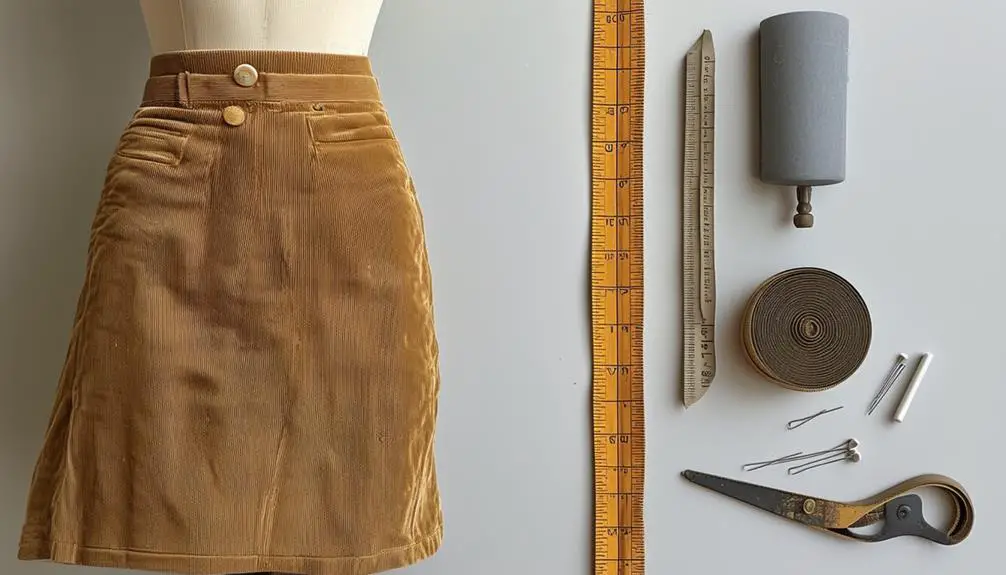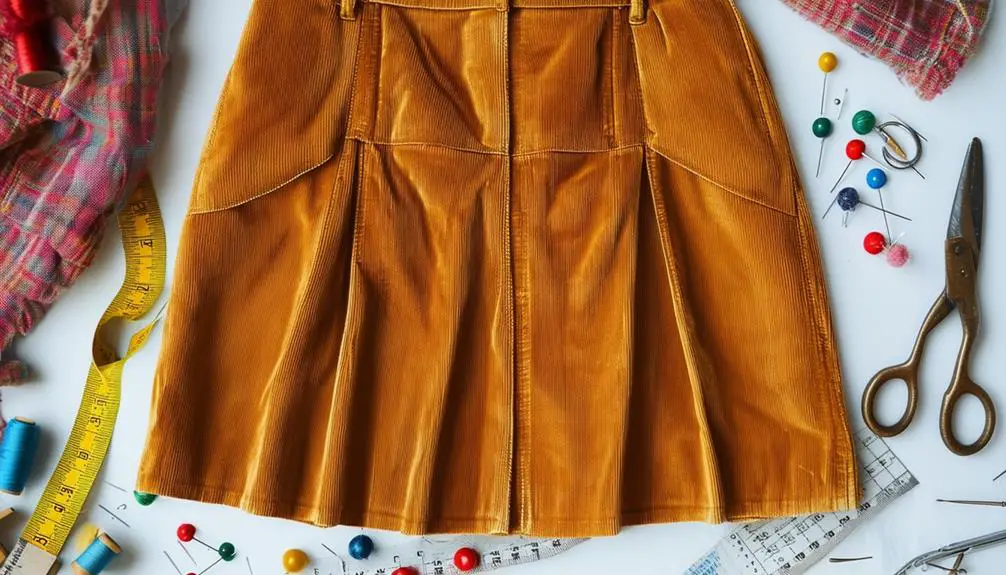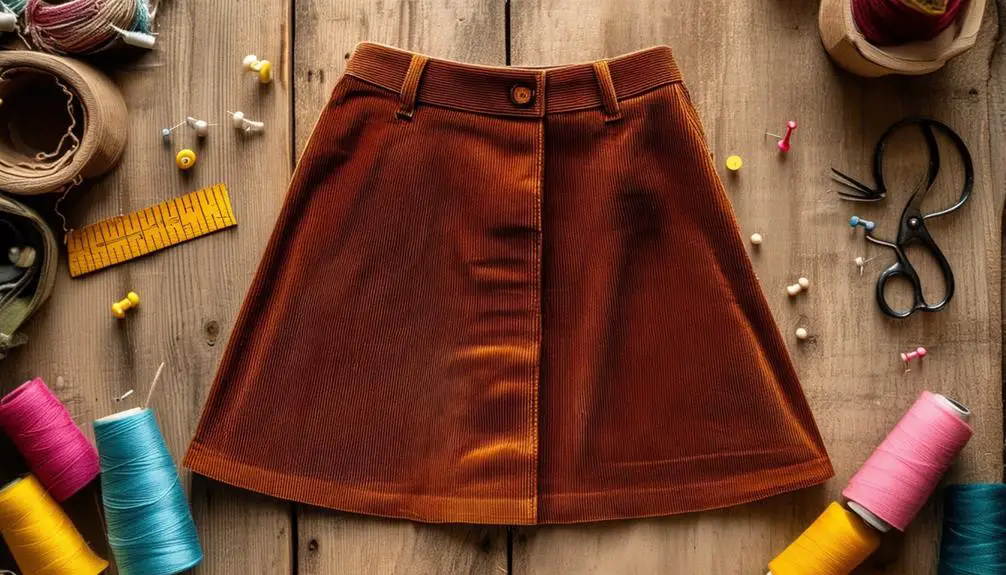To tailor a vintage corduroy skirt, start by evaluating the fit at the waist and hips, ensuring it hugs you comfortably without gaping. Use a seam ripper to adjust the waistband, sewing in or letting out as needed. For a polished finish, hem the skirt to a length that flatters — around mid-thigh or above the knee is ideal. Don't forget to topstitch for durability and style! Finally, consider the unique texture of corduroy when cutting and sewing. If you're curious about styling tips and more intricate tailoring techniques, there's plenty more to explore!
Assessing the Skirt Fit

When it comes to finding the perfect fit for your vintage corduroy skirt, comfort is key. Start by evaluating the skirt fit at the waistband; it should sit snugly without digging into your skin. If it feels too tight or loose, you won't enjoy wearing it.
Next, grab a measuring tape and measure your hip width across the fullest part while wearing the skirt. This guarantees it hugs your curves just right, striking a balance between snug and comfortable.
Now, evaluate the length by standing straight. Ideally, the skirt should fall around mid-thigh or just above the knee, creating a flattering silhouette that's all the rage.
As you check the fit, look for any gaping or pulling at the seams, especially around the waist and hips—these signs indicate whether the skirt needs adjusting.
Lastly, consider your ease of movement. You should be able to walk, sit, and bend comfortably without feeling restricted.
When you nail these fit factors, your vintage corduroy skirt won't only look chic but also feel great, making it a timeless addition to your wardrobe.
Adjusting the Waistband
To achieve the perfect fit for your vintage corduroy skirt, adjusting the waistband is crucial, especially if it feels too tight or loose. Vintage clothing often features unique designs and craftsmanship, making it important to handle adjustments with care.
Start by measuring your waist and comparing it to the existing waistband. This'll help you determine how much to take in or let out. Grab a seam ripper and carefully remove the stitching holding the waistband in place, taking care not to damage the soft corduroy fabric.
If you're taking in the waistband, pin the new seam allowance and sew a straight stitch, reinforcing the ends to prevent fraying. For letting out, be mindful of the fabric's nap and confirm the original hemline is preserved for a clean finish.
Understanding the historical context of brands can enhance your appreciation for the uniqueness of your skirt, especially if it features labels from sought-after designers like Fashionbilt or others from the 60s and 70s.
After you've made your adjustments, press the new waistband seam flat for a polished look. If you want to add durability and a touch of style, consider topstitching along the new seam. This not only enhances the aesthetic but also guarantees your front pockets remain functional and stylish.
With these adjustments, you'll not only enjoy a better fit but also embrace the timeless elegance of your vintage corduroy skirt!
Hem Length Considerations

After perfecting the waistband, it's time to focus on the hem length, a key element that can dramatically influence the overall aesthetic of your vintage corduroy skirt.
When it comes to hem length considerations, a standard finish of around 1.25 inches works well for casual styles. However, opting for a wider hem of 1.5 inches not only enhances the skirt's durability but also contributes to a more polished look. This balance of style and function is vital.
While tailoring, remember to honor the original design and fabric characteristics. A wider hem keeps the casual vibe intact while providing better weight distribution. Topstitching the hem adds both flair and stability, especially with heavier fabrics like corduroy.
If you're aiming for a sleek finish, consider using a blind hem technique; it delivers a professional touch without bulk.
Lastly, don't forget to account for the fabric's nap direction when cutting and hemming. This guarantees a consistent appearance, allowing your vintage corduroy skirt to truly shine.
With these hem length considerations, you're well on your way to creating a chic, tailored piece!
Tools and Materials Needed
Gathering the right tools and materials is essential for successfully tailoring your vintage corduroy skirt. Start with a reliable sewing machine, as it's your best friend in this creative journey.
You'll also need sharp fabric scissors to guarantee clean cuts and precision. Don't forget pins to hold your fabric in place while you work on your masterpiece. A measuring tape is critical for accurate adjustments, helping you achieve that perfect fit.
A seam ripper is a must-have tool for carefully undoing existing seams without damaging the fabric's unique texture—especially important with corduroy's distinct nap. For marking alterations, opt for tailoring chalk or a fabric marker, which allows for clear, temporary lines that won't leave a lasting impression.
To achieve crisp hems and seams, a pressing iron with a steam function is essential. Corduroy holds creases beautifully when pressed correctly, enhancing its vintage charm.
Finally, if you want to elevate your sewing game, consider using a walking foot attachment for your sewing machine. This handy tool helps manage the thickness of corduroy layers, guaranteeing everything stays perfectly aligned during sewing.
With these essentials, you're all set to transform your skirt!
Step-by-Step Tailoring Process

When you're ready to transform your vintage corduroy skirt, start by slipping it on to pinpoint exactly where adjustments are needed, whether it's the waistband or the length. Use tailor's chalk to mark the areas for precision.
Next, carefully unpick the waistband or hem with a seam ripper, guaranteeing you preserve the fabric while avoiding damage to the corduroy nap. If you're looking to reduce bulk, opt for a thinner fabric for facings or pockets. As you sew, press seams open for a streamlined look.
When shortening the skirt, aim for a hem width of at least 1.5 inches to maintain that casual aesthetic and guarantee proper weight distribution. Topstitching your hem adds durability and a polished finish.
Finally, reattach the waistband or hem using a blind stitch or chain stitch to achieve a clean, professional appearance that complements your vintage style.
Here's a handy table summarizing the tailoring steps:
| Step | Description |
|---|---|
| Identify Adjustments | Try on the skirt and mark with tailor's chalk |
| Unpick with Care | Use a seam ripper, preserve fabric integrity |
| Final Touches | Reattach waistband/hem with a clean stitch |
Finishing Touches
How can you elevate the final look of your vintage corduroy skirt? Start by incorporating topstitching along the hemline. This not only enhances the visual appeal but also adds durability, ensuring your skirt stands the test of time.
For a clean and polished finish, consider a blind hem, which minimizes visible stitching on the outside, giving it a sleek appearance. Vintage clothing often features unique construction techniques, so paying attention to these details can greatly enhance your piece's authenticity and charm. If you're interested in more about identifying vintage styles, check out identifying vintage clothing.
Next, pay attention to the waistband and pockets. Using hand-stitching techniques here can elevate your project, particularly with thicker corduroy fabric. It lends a refined, professional look that factory finishes often lack.
Don't forget to properly press and finish the hem to maintain the skirt's shape. This step is essential to prevent fraying or distortion over time, preserving that vintage charm.
If you're feeling adventurous, experiment with a chain stitch hem. This technique not only complements the classic style of a corduroy skirt but also offers flexibility, ensuring comfort as you move.
With these finishing touches, your tailored skirt will be a standout piece that reflects your unique style while boasting an impeccable finish.
Tips for Working With Corduroy

Working with corduroy can be a delightful experience, but a few key tips can make all the difference. First, always cut all your pattern pieces in the same direction. This guarantees a consistent nap and texture, giving your skirt that polished look.
Next, grab a thicker needle, like a denim needle, and use a longer stitch length. This prevents damage to the fabric while sewing, keeping your project on track.
When it comes to reducing bulk at seams, consider using thinner fabrics for facings and pockets, such as cotton poplin. It pairs beautifully with corduroy and keeps everything neat.
Remember to press your seams carefully; this step can elevate your final product. Using overlocking will finish edges nicely, as corduroy is prone to fraying due to its unique texture.
Styling Your Tailored Skirt
Your tailored vintage corduroy skirt is a versatile piece that can effortlessly elevate your wardrobe. Pair it with a fitted turtleneck or a classic button-up shirt for a polished, timeless look that fits various occasions.
To enhance your silhouette, accessorize with a wide belt, which perfectly accentuates your waist and complements the skirt's A-line shape. Footwear choices like ankle boots or loafers will add a chic yet comfortable vibe, enhancing the casual aesthetic of the corduroy fabric.
For a layered look, consider adding a tailored blazer or a denim jacket. This creates contrast and depth while keeping your outfit cohesive and stylish.
Don't hesitate to experiment with seasonal colors and prints in your tops and accessories. Corduroy skirts are adaptable and can seamlessly shift across different seasons, making them a staple in your wardrobe.
If you're feeling adventurous, try pairing your skirt with a midi dress underneath for an unexpected twist that adds dimension and flair to your outfit.
With these styling tips, your tailored vintage corduroy skirt will become a go-to piece you'll reach for time and again.
Frequently Asked Questions
How to Hem a Corduroy Dress?
When hemming a corduroy dress, you'll want a wide hem for weight distribution. Topstitching adds flair, while hand-stitching guarantees a clean finish. Remember to cut with the nap direction for a polished look!
How to Adjust a Skirt That's Too Big?
To adjust a skirt that's too big, measure the excess, unpick seams carefully, pin the new line, try it on, then sew with a straight or zigzag stitch to secure your chic look effortlessly.
Are Corduroy Skirts Still in Style?
Yes, corduroy skirts are definitely still in style! They blend vintage charm with modern flair, offering warmth and versatility. You can effortlessly dress them up or down for any occasion, making them a wardrobe essential.
How Do You Style a Corduroy Skirt?
To style a corduroy skirt, you'll want to mix textures. Pair it with a fitted top, layer with a chic jacket, and choose knee-high boots for an effortlessly trendy look that shifts perfectly through the seasons.




